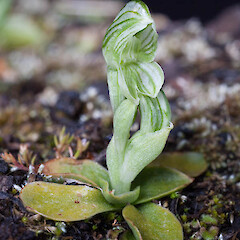Pterostylis tanypoda
Synonyms
Hymenochilus tanypodus (D.L.Jones, Molloy et M.A. Clem.) D.L.Jones, M.A.Clem. et Molloy
Family
Orchidaceae
Flora category
Vascular – Native
Endemic taxon
Yes
Endemic genus
No
Endemic family
No
Structural class
Orchids
NVS code
The National Vegetation Survey (NVS) Databank is a physical archive and electronic databank containing records of over 94,000 vegetation survey plots - including data from over 19,000 permanent plots. NVS maintains a standard set of species code abbreviations that correspond to standard scientific plant names from the Ngä Tipu o Aotearoa - New Zealand Plants database.
HYMTAN
Chromosome number
2n = 54
Current conservation status
The conservation status of all known New Zealand vascular plant taxa at the rank of species and below were reassessed in 2017 using the New Zealand Threat Classification System (NZTCS) – more information about this can be found on the NZTCS website. This report includes a statistical summary and brief notes on changes since 2012 and replaces all previous NZTCS lists for vascular plants.
Please note, threat classifications are often suggested by authors when publications fall between NZTCS assessment periods – an interim threat classification status has not been assessed by the NZTCS panel.
- Conservation status of New Zealand indigenous vascular plants, 2017 . 2018. Peter J. de Lange, Jeremy R. Rolfe, John W. Barkla, Shannel P. Courtney, Paul D. Champion, Leon R. Perrie, Sarah M. Beadel, Kerry A. Ford, Ilse Breitwieser, Ines Schönberger, Rowan Hindmarsh-Walls, Peter B. Heenan and Kate Ladley. Department of Conservation. Source: NZTCS and licensed by DOC for reuse under the Creative Commons Attribution 4.0 International licence.
2017 | At Risk – Declining | Qualifiers: DP, EF, Sp
Previous conservation statuses
2012 | At Risk – Declining | Qualifiers: DP, EF, Sp
2009 | Not Threatened | Qualifiers: DP, EF
2004 | Sparse
Distribution
Endemic. New Zealand: South Island (east of the main divide from Marlborough to Southland).
Habitat
Montane to subalpine, usually in intermontane basins, on river terraces or on low relief foothills, amongst tussock grasses, in grey scrub or in shingle. Sometimes found in grassland dominated by exotic species.
Detailed description
Somewhat fleshy, glaucescent, inconspicuous orchid 20–100 mm tall when flowering. Stem fleshy, hidden by numerous leafy bracts. Rosette leaves numerous, 5–15 × 5–12 mm; bluish-green to glaucous (rarely yellow-green), ovate, leaf tapering gradually to a broadly winged petiole; cauline leaves similar but smaller. Inflorescence a compact raceme of 1–7 flowers, each partially enclosed within a sheathing floral bract; perianth bluish-green with pale stripes. Dorsal sepal 5–10 mm, broad, apiculate. Lateral sepals slightly shorter, almost completely fused into a flat lamina; this apically bidentate, and strongly deflexed in fully opened flower. Petals just shorter than dorsal sepal, the anterior margin smooth. Labellum short, braod, obtuse, prolonged backwards into a smoothly rounded appendage surmounted by a thick, rather prominent, forward jutting median knob. Column short, broad; wings broader than long, ciliate over most of their free margins; stigma oblong.
Manaaki Whenua Online Interactive Key
Similar taxa
Could only be confused with P. tristis Colenso from which it differs in its glaucescent rather than brownish-green foliage and blue-green to green rather than brownish-green flowers. In P. tristis the labellum base possesses a backward projecting decurved appendage, while in P. tanypoda the labellum is even more strongly deflexed and it is always surmounted with a prominent, smooth forward-pointing knob. While P. tristis can occasionally be glaucescent, P. tanypoda is never brown-green. The two species may grow together.
Flowering
October–January
Flower colours
Blue, Green
Fruiting
November–April
Life cycle
Minute seeds are wind dispersed (Thorsen et al., 2009).
Propagation technique
Difficult—should not be removed from the wild
Threats
An apparently naturally uncommon biologically sparse species. However, its preferred habitat of open, short tussock grassland has been extensively modified and it very probably has declined in the past. The problem is one cannot quantify this. Furthermore, this species is easily overlooked and so its exact distirbution and abundance remains unclear.
Etymology
pterostylis: Winged column
Taxanomic notes
Jane et al. (2010) following a thorough rDNA (ITS) based analysis of the segregate genera erected for Pterostylis R.Br. by Szlachekto (2001) and Jones et al. (2002) found no support to continue their recognition. This view is followed here.
Attribution
Fact Sheet prepared for NZPCN by P.J. de Lange (14 April 2007). Description based on Jones et al. (1997) - as Pterostylis tanypodus
References and further reading
Janes JK, Duretto MF. 2010. A new classification for subtribe Pterostylidinae (Orchidaceae), reaffirming Pterostylis in the broad sense. Australian Systematic Botany 23: 260–269. https://doi.org/10.1071/SB09052.
Jones DL, Molloy BPJ, Clements MA. 1997. Six new species of Pterostylis R.Br. (Orchidaceae) from New Zealand. The Orchadian 12: 266–281.
Jones DL, Clements MA, Molloy BPJ. 2002. A Synopsis of the Subtribe Pterostylidinae. Australian Orchid Research 4: 129–146.
Szlachekto, D.L. 2001: Genera et Species Orchidalium 1. Polish Botanical Journal 46(1): 11–26.
Thorsen MJ, Dickinson KJM, Seddon PJ. 2009. Seed dispersal systems in the New Zealand flora. Perspectives in Plant Ecology, Evolution and Systematics 11: 285–309. https://doi.org/10.1016/j.ppees.2009.06.001.
NZPCN Fact Sheet citation
Please cite as: de Lange, P.J. (Year at time of access): Pterostylis tanypoda Fact Sheet (content continuously updated). New Zealand Plant Conservation Network. https://www.nzpcn.org.nz/flora/species/pterostylis-tanypoda/ (Date website was queried)









